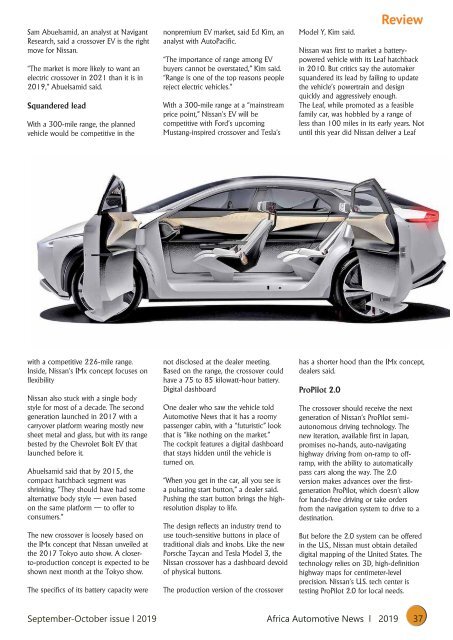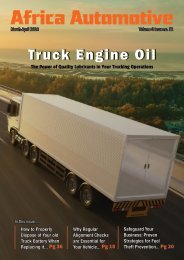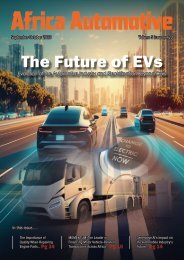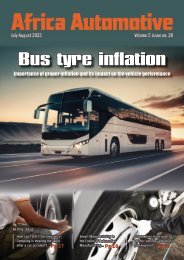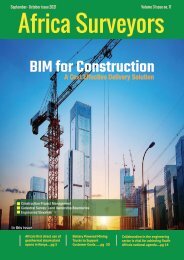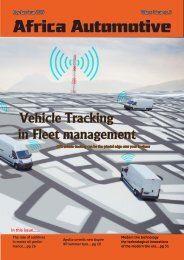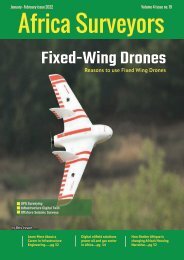Africa Automotive News September-October digital issue 2019
Africa Automotive prides itself to be the ONLY Africa’s leading and MOST authoritative magazine for the automotive industry in Africa with printed copies for the automotive industry decision makers in both government, NGO’s and private sector. The Bi-monthly magazine offers cost effective advertising services that get results and improves growth in the auto B2C and B2B sector, keeping an eye on latest technologies in Africa and across the world, the magazine predominately covers the developments in the Africa auto industry.
Africa Automotive prides itself to be the ONLY Africa’s leading and MOST authoritative magazine for the automotive industry in Africa with printed copies for the automotive industry decision makers in both government, NGO’s and private sector. The Bi-monthly magazine offers cost effective advertising services that get results and improves growth in the auto B2C and B2B sector, keeping an eye on latest technologies in Africa and across the world, the magazine predominately covers the developments in the Africa auto industry.
Create successful ePaper yourself
Turn your PDF publications into a flip-book with our unique Google optimized e-Paper software.
Sam Abuelsamid, an analyst at Navigant<br />
Research, said a crossover EV is the right<br />
move for Nissan.<br />
“The market is more likely to want an<br />
electric crossover in 2021 than it is in<br />
<strong>2019</strong>,” Abuelsamid said.<br />
Squandered lead<br />
With a 300-mile range, the planned<br />
vehicle would be competitive in the<br />
nonpremium EV market, said Ed Kim, an<br />
analyst with AutoPacific.<br />
“The importance of range among EV<br />
buyers cannot be overstated,” Kim said.<br />
“Range is one of the top reasons people<br />
reject electric vehicles.”<br />
With a 300-mile range at a “mainstream<br />
price point,” Nissan’s EV will be<br />
competitive with Ford’s upcoming<br />
Mustang-inspired crossover and Tesla’s<br />
Model Y, Kim said.<br />
Review<br />
Nissan was first to market a batterypowered<br />
vehicle with its Leaf hatchback<br />
in 2010. But critics say the automaker<br />
squandered its lead by failing to update<br />
the vehicle’s powertrain and design<br />
quickly and aggressively enough.<br />
The Leaf, while promoted as a feasible<br />
family car, was hobbled by a range of<br />
less than 100 miles in its early years. Not<br />
until this year did Nissan deliver a Leaf<br />
with a competitive 226-mile range.<br />
Inside, Nissan’s IMx concept focuses on<br />
flexibility<br />
Nissan also stuck with a single body<br />
style for most of a decade. The second<br />
generation launched in 2017 with a<br />
carryover platform wearing mostly new<br />
sheet metal and glass, but with its range<br />
bested by the Chevrolet Bolt EV that<br />
launched before it.<br />
Abuelsamid said that by 2015, the<br />
compact hatchback segment was<br />
shrinking. “They should have had some<br />
alternative body style — even based<br />
on the same platform — to offer to<br />
consumers.”<br />
The new crossover is loosely based on<br />
the IMx concept that Nissan unveiled at<br />
the 2017 Tokyo auto show. A closerto-production<br />
concept is expected to be<br />
shown next month at the Tokyo show.<br />
The specifics of its battery capacity were<br />
not disclosed at the dealer meeting.<br />
Based on the range, the crossover could<br />
have a 75 to 85 kilowatt-hour battery.<br />
Digital dashboard<br />
One dealer who saw the vehicle told<br />
<strong>Automotive</strong> <strong>News</strong> that it has a roomy<br />
passenger cabin, with a “futuristic” look<br />
that is “like nothing on the market.”<br />
The cockpit features a <strong>digital</strong> dashboard<br />
that stays hidden until the vehicle is<br />
turned on.<br />
“When you get in the car, all you see is<br />
a pulsating start button,” a dealer said.<br />
Pushing the start button brings the highresolution<br />
display to life.<br />
The design reflects an industry trend to<br />
use touch-sensitive buttons in place of<br />
traditional dials and knobs. Like the new<br />
Porsche Taycan and Tesla Model 3, the<br />
Nissan crossover has a dashboard devoid<br />
of physical buttons.<br />
The production version of the crossover<br />
has a shorter hood than the IMx concept,<br />
dealers said.<br />
ProPilot 2.0<br />
The crossover should receive the next<br />
generation of Nissan’s ProPilot semiautonomous<br />
driving technology. The<br />
new iteration, available first in Japan,<br />
promises no-hands, auto-navigating<br />
highway driving from on-ramp to offramp,<br />
with the ability to automatically<br />
pass cars along the way. The 2.0<br />
version makes advances over the firstgeneration<br />
ProPilot, which doesn’t allow<br />
for hands-free driving or take orders<br />
from the navigation system to drive to a<br />
destination.<br />
But before the 2.0 system can be offered<br />
in the U.S., Nissan must obtain detailed<br />
<strong>digital</strong> mapping of the United States. The<br />
technology relies on 3D, high-definition<br />
highway maps for centimeter-level<br />
precision. Nissan’s U.S. tech center is<br />
testing ProPilot 2.0 for local needs.<br />
<strong>September</strong>-<strong>October</strong> <strong>issue</strong> l <strong>2019</strong><br />
<strong>Africa</strong> <strong>Automotive</strong> <strong>News</strong> l <strong>2019</strong> 37


